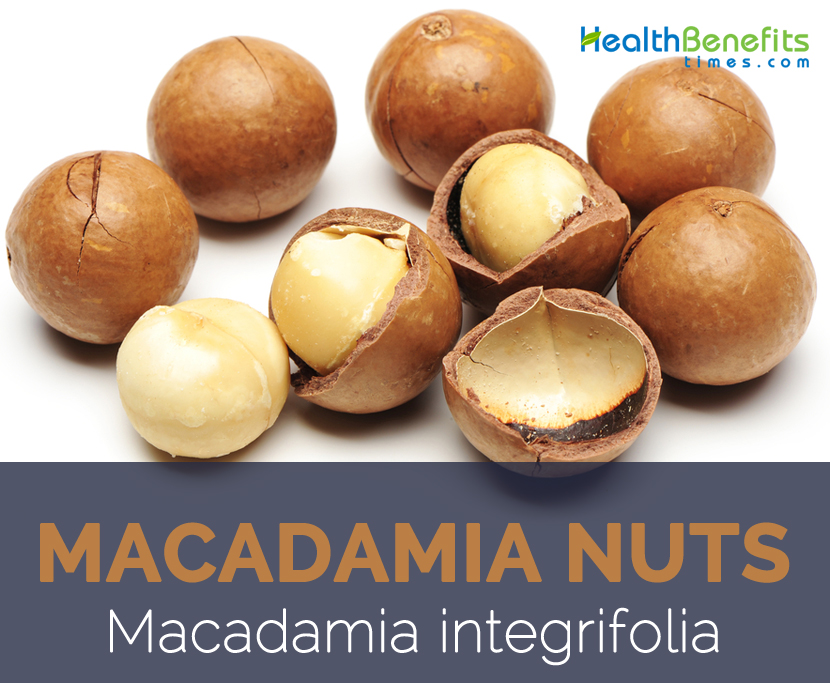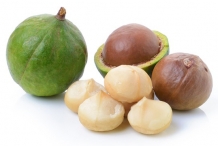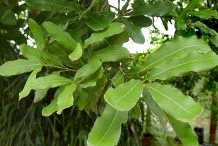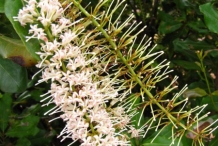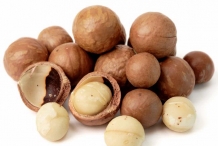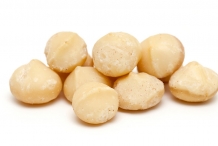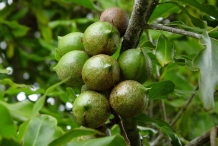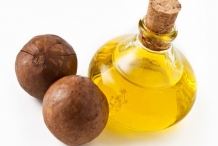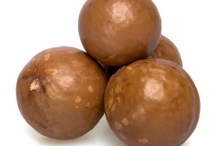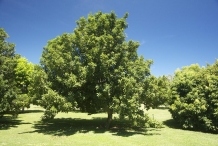Plant
Macadamia nut are actually an evergreen tree, 20 m in tall with a 20 m wide crown and is normally found growing in mild, frost-free climate with plentiful rainfall distributed throughout the year. It thrives well in deep, well drained, moist soil rich in organic matter and sandy loams. The plant has deep tap root and comparatively few lateral roots along with trunk of 30 cm diameter.
Leaves
Leaves are normally in whorls of 3, pale green or bronze when young becoming dark green; petiole 4–18 mm. Lamina is simple, narrow-elliptical to oblanceolate, 10–30 cm long, leathery, base attenuate, margin irregularly spiny toothed when young becoming smooth, entire, apex acute to obtuse and sometimes retuse.
Flowers
Flowers are borne on long narrow racemes arising from the axils of leaves or the scars of fallen leaves. They may be borne on the new growth if it is mature, but more often on the two or three season’s growth proceeding the most recently matured flushes. The flowers, about 1/2 inches long are perfect but incomplete in that they have no petals, but four petaloid sepals. M. integrifolia has creamy white flowers borne in clusters 6 to 12 inches long, while the flowers of M. tetraphylla are cream-colored or pink and borne in clusters up to 15 inches long. Macadamias can self-pollinate, although varieties vary from being totally self-compatible to being almost self-sterile. Wind pollination may play some role, but bees are apparently the major agent in pollination. Cross-pollination by hand has been shown to increase nut set and quality.
Fruit
Macadamia nuts are globular follicle, with an apical horn, 25 mm diameter, consisting of a fleshy green pericarp 3 mm thick, enclosing a globular to broadly ovoid smooth-testa seed. Seeds are normally 20–30 mm across, hard, brown, smooth. Flesh is normally creamy white and have nutty aroma and are sweet in taste. Because of its higher nutritional value as well as wonderful taste it is presently used in several food items around the world.
History
Macadamia integrifolia is native to coastal rainforests of central eastern Australia. The species occurs naturally in remnant forests from Mt Bauple, north of Gympie to Currumbin Valley in the Gold Coast hinterland in Queensland. While specimens have been collected from the North Coast of NSW, this species is not known to occur naturally in NSW. Along with the Rough-shelled Bush Nut, this species forms the basis of the commercial macadamia nut industry in Australia and Hawaii, usually as a hybrid selection. Australia and Hawaii are the world’s leading producers followed by Costa Rica, but macadamias are now grown in other countries including Kenya, South Africa, Malawi, Tanzania, Brazil, Sri Lanka, New Zealand, Thailand and in Central America.
Nutritional Value
Apart from their nutty aroma and sweet taste, Macadamia nut is a good source of nutrients, vitamins and minerals. Consuming 134 gram of macadamia offers 101.53 g of Total Fat, 5.536 mg of Manganese, 1.601 mg of Vitamin B1, 1.013 mg of Copper, 4.94 mg of Iron, 174 mg of Magnesium, 252 mg of Phosphorus and 11.5 g of Total dietary Fiber. Moreover many Amino acids 0.09 g of Tryptophan, 0.496 g of Threonine, 0.421 g of Isoleucine, 0.807 g of Leucine, 0.024 g of Lysine, 0.031 g of Methionine are also found in 134 gram of Macadamia nuts.
Health benefits of Macadamia nuts
Consuming nuts on a regular basis has a positive effect on the health. These sweet, creamy, crunchy, and luxurious nuts are more often than not thought of as high fat indulgence rather than health food. But Macadamia contains variety of nutritious and health-promoting nutrients that make them an important part of our daily diet. A balanced diet containing macadamias promotes good health, longevity and a reduction in regenerative diseases.
1. Keep the Brain and Nervous System on Point
Copper, vitamin B1, magnesium and manganese found in macadamia nuts help make healthy neurotransmitters, which are actually an important chemicals that our brain cells need to send signals to the brain. Macadamia nuts are also high in oleic acid, which aids in brain health, and they contain palmitoleic acid, which help to protect nerve cells in the brain — thus contributing to healthy brain function.(1)
2. Prevents Hair Breakage
According to experts, macadamia nut oil helps to keep hair healthy and prevents breaking. It enters hair follicles and the scalp and helps in the improvement of hair elasticity and strength. With so many biological and environmental factors that cause hair breakage, macadamia nut oil is an excellent oil to have to reverse the damage done to your hair.
3. Dietary Fiber
Macadamias consists of about 7% of dietary fiber. Dietary fiber comprises of complex carbohydrates and includes many types of soluble and insoluble fiber. Dietary fiber promotes satiety, offers roughage, aids digestion and assist in reducing constipation and several other diseases related to it.(2)
4. Delays Skin Aging
Benefits of macadamia nut oil for skin are surplus. Macadamia nut oil has a high content of palmitoleic fatty acids. This is a nutrient that has great skin benefits as it delays the process of cell and skin aging. Because palmitoleic acid gets depleted fast as skin ages, it is essential to have this oil. This is one of the reasons why macadamia nut oil is a key ingredient in many anti-aging products.
5. For Weight Loss
People commonly avoid eating macadamia thinking that it is loaded with fats as well as cholesterol. However, the fat in macadamia is monounsaturated fats which encourage weight loss. Macadamia nuts are rich in palmitoleic acid, and omega 7 fatty oil that provide building blocks for the enzymes and control the burning of fat and curb the appetite. Palmitoleic acid helps to increase fat metabolism and reduces fat storage. Their fatty acids content makes them an extremely satisfying food, and you will need only a handful to feel satisfied. (3)
6. Bone Health
Macadamia nut consists of good amount of phosphorus which plays a variety of roles including bone and teeth mineralization, metabolism, absorption and transportation of nutrients. Calcium helps in the formation of teeth and bones. Manganese in macadamia helps the body to deposit new bone tissue, so that the skeleton stays strong as you age. Omega 3 prevents osteoporosis and decreases the severity of arthritis.
7. Heart Disease
Macadamia nuts are 100% cholesterol-free and are highly beneficial to decrease cholesterol level. These nuts are rich in healthy monounsaturated fats which are supposed to be cardio protective by reducing cholesterol level and help to clean the arteries. Macadamia also helps to lowers the level of triglycerides, which is a kind of body fat and reduces the risk of coronary disease.(4)
8. Support the Gut
Macadamia nuts consist of both soluble and insoluble dietary fiber that helps you feel full while removing toxins from the body and assisting in good digestion. As a copper-rich food, the macadamia nut helps with the efficient utilization of iron and aids in proper enzymatic reactions.(5)
9. Provides Hydration
Many factors, including beauty treatments, hot showers, etc. reduce moisture from your hair and skin. To make them healthy, you need to keep them well-hydrated. As mentioned previously, our body naturally produces palmitoleic acid, but it quickly gets depleted with age. The omega-7 that macadamia nut oil provides plays an important role in replenishing palmitoleic acid in your body and keeps your skin and hair hydrated.
10. Antioxidants
Macadamia consists of high flavonoid content. Flavonoids, which are found naturally in these plants help to prevent cells from damage and protects from environmental toxins. These flavonoids convert into antioxidants in our body. These antioxidants search and destroy free radicals and protect our bodies from numerous diseases and certain types of cancer, which include breast, cervical, lung, prostate, and stomach cancer.(6)
11. Protects Skin and Hair
Antioxidant properties of macadamia nut oil help to protect your body from free radicals, as well as protect both skin and hair too. Skin and hair are extremely susceptible to the damage caused by free radicals. The antioxidants in this oil protect your skin and hair from such damage and ensure health from within. You can get glowing, youthful skin and strong, lustrous hair.
https://www.youtube.com/watch?v=SHhFT-9wbV8
How to Eat
- Macadamia nuts are eaten raw or after cooking in oil are roasted and salted.
- Macadamia is available in variety of styles to suit different applications in snacks, confectionery, and catering, baking and home use.
- Macadamia nuts are sold by the primary processor as raw, roasted, salted or flavored.
- Macadamias are consumed as snack or used in food dishes, desserts and confectionery.
- Fancy pastries, candies and ice cream, have been made from it.
- It goes well with beef lamb, poultry, and pork or seafood dishes.
- It is commonly use in salads, spaghetti, soups, noodle, fritters and couscous dishes.
- Confectionary uses include muffins, cakes, cookies such as Macadamia and fruit Florentines, chocolates, Macadamia biscotti, biscuits, chocolate wedges, tartlets, brownies, chocolate.
- It is also relish in desserts like ice cream, mixed berry mille, meringue, marzipan, parfait, macadamia baklava, macadamia and mousse.
- Years ago a coffee-like beverage known as “almond coffee” was marketed from the seeds.
- Sprinkle chips and halves over desserts, mainly sundaes and other ice cream based recipes.
Other facts
- Macadamia is planted as an ornamental or shade tree in home gardens.
- It has been inter-cropped with coffee and food crops without affecting the yield of these crops in Kenya.
- Tree offers timber but is not generally exploited.
- Wood is reddish, hard and tough, attractively marked, used in small turnery jobs.
- Macadamia shell can be used as fuel, generating sufficient energy to dry wet, in shell nuts.
- Decomposed husk is used in potting soils and the ground shell supplied to the plastic industry.
Precautions
- Health care providers occasionally recommend macadamia nuts to promote digestion and relieve constipation, but eating too many of them may lead to constipation or diarrhea in some people.
Storage
Because of the high fat content of macadamia nuts, it’s essential to store them appropriately to keep them from turning rancid. Unopened containers may be stored in the refrigerator for up to six months, or in the freezer for up to a year. Once the nuts are opened, it’s best to keep them in the refrigerator and consume them within two months. Macadamia nuts should be light in color. If they start to darken, that’s a sign that they are starting to turn rancid and it’s best to through them out.
Method to Store and Roast Macadamia Nuts
If you prefer them roasted, here is what you need to do:
- Preheat your oven to 225–250 degrees F.
- Place the nut meats (the actual edible part of the nuts, not the casings) on a cookie sheet. It’s best to roast pieces that are similar in size for consistency.
- Simply roast for about 10 minutes, keeping an eye on them since oven temperatures can vary.
- Remove from the oven as soon as they begin to turn slightly brown.
- Allow them to cool.
- Store in a tightly sealed container.
References:
https://en.wikipedia.org/wiki/Macadamia
https://www.crfg.org/pubs/ff/macadamia.html
https://macnuts.org/growpage.htm
http://www.avocadosource.com/CAS_Yearbooks/CAS_38_1953-54/CAS_1953-54_PG_063-067.pdf
Comments
| Macadamia Nuts Quick Facts | |
|---|---|
| Name: | Macadamia Nuts |
| Scientific Name: | Macadamia integrifolia |
| Origin | Native to coastal rainforests of central eastern Australia. |
| Colors | Green pericarp enclosing globular brown seed |
| Shapes | Globular follicle, with an apical horn, 25 mm diameter, |
| Flesh colors | Creamy white |
| Taste | Sweeyt |
| Calories | 962 Kcal./cup |
| Major nutrients | Total Fat (290.09%) Manganese (240.70%) Vitamin B1 (133.42%) Copper (112.56%) Iron (61.75%) |
| Health benefits | Protects Skin and Hair, Antioxidants, Provides Hydration, Support the Gut, Heart Disease, Bone Health, For Weight Loss,Delays Skin Aging, Dietary Fiber,Prevents Hair Breakage, Keep the Brain and Nervous System on Point |
| More facts about Macadamia Nuts | |
| Rank | Scientific Name & (Common Name) |
|---|---|
| Kingdom | Plantae (Plants) |
| Subkingdom | Tracheobionta (Vascular plants) |
| Superdivision | Spermatophyta (Seed plants) |
| Division | Magnoliophyta (Flowering plants) |
| Class | Magnoliopsida (Dicotyledons) |
| Subclass | Rosidae |
| Order | Proteales |
| Family | Proteaceae (Protea family) |
| Genus | Macadamia F. Muell. (Macadamia) |
| Species | Macadamia integrifolia Maiden & Betche (Macadamia nut) |
| Synonyms |
|


